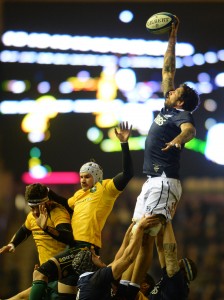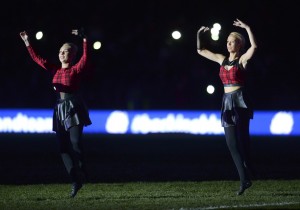
Downhearted: Kelly Brown plugged away for Scotland and they could hsve won, but Australia found a way to win
By Scottish Rugby Blog’s Rory Baldwin
Here are five things that stand out after Scotland’s 15-21 loss to the visiting Wallabies.
We still don’t know Scotland’s strongest team
When our top team is available, we should be able to offer a challenge to most teams bar the All Blacks, if perhaps not beat many of them. There are talented rugby players in Scotland.
Our two main problems are a lack of depth in certain key areas or an unwillingness to test the depth, and as a result we don’t really know our top team ahead of the Six Nations. We’ve seen Ross Ford, Sean Maitland, David Denton and Nick De Luca start all three tests, to name but a few. Meaning that talent like Chris Fusaro, Mark Bennett, Kieran Low, Blair Cowan, Rob Harley, Greig Tonks or Pat MacArthur remain relatively untried at the top level.
That South Africa match would have been a perfect proving ground for young players – it’s not going to get much more difficult than that for an attacker or a defender and the score couldn’t have been much worse.
Scott Johnson said in the final press conference that his plan had always been to replace Ford at half time against Australia, as he needed to see MacArthur get more game time. As we’re well aware of Ford’s capabilities, this was a decision that could have been taken a lot earlier in the series, perhaps before it began.
Instead, Ford has had two and a half games to underperform, while Hall, Lawson and MacArthur have had little opportunity. We think MacArthur is the closest second choice hooker, but we’re not sure. Which isn’t where we want to be at this stage.
Playing three No 8s is not the greatest plan in the world
The openside thing: I’m going to bang on about it again, sorry. Michael Hooper was outstanding for Australia, slowing down the Scottish ball single-handedly and controlling the pace Scotland were allowed to play at. Scotland, in return, had very little control over Australia at the breakdown. Sure, Brown (playing 7 but not a 7) and Beattie (playing 6 and not a 6) tackled everything manfully enough but there wasn’t enough breakdown technique there to outwit Australia who are very well drilled. As a result, Scotland got little quick ball, precious few turnovers, and struggled to make headway.
Unfortunately, Australia have good breakdown technique throughout and scramble defence allowed them to recover sufficiently to prevent the try Scotland desperately needed when they did break clear.
Some good news is that Ross Rennie played 40 minutes for Edinburgh against Ulster at the weekend, and if Johnson continues to ignore everyone else, Rennie’s return can’t come quickly enough.
Other positional problems that will plague the Scotland management going forward: we lack depth at hooker, tighthead and at fullback.
On the other hand, the second row is looking strong
Jim Hamilton earned his 50th cap against Australia, and while he still gives away the odd rash penalty, he has taken over admirably from Nathan Hines as Scotland’s enforcer. With Tim Swinson rapidly becoming a major power in this Scotland squad, the giant Gray brothers become icing on the cake. It does mean there is little room for the master tactician Al Kellock, but he will surely be passing on all he knows to Gray and Swinson at Glasgow.
Murrayfield can still raise an atmosphere outside of the Six Nations
Until recently, the autumn Internationals tended to be a bit of a soulless affair, with paltry crowds or the atmosphere provided by the visiting fans. The SRU is often criticised for a lack of good sense but in terms of ticketing they’ve struck a winner, offering great value season passes for all of the home games including the Six Nations, allowing fans access to those big games that has the pleasant side effect of a consistent crowd across the Autumn tests too.
Following family-oriented pre-match entertainments and a little razzmatazz (even Scott Johnson liked the light show on Saturday), the atmosphere at the start of all three games was excellent. Although it went rapidly downhill during the South African onslaught, the Australia game was noisy throughout the game, despite Scotland’s woes. Performance on the park is a big factor, as Scotland fans will forgive ineptitude as long as there is heart. Of course another possible explanation was the 6pm kickoff; everyone had been in the pubs all afternoon!
Scotland still struggle to score tries
Without the strike runners we have uncovered in recent seasons in Stuart Hogg and Tim Visser, and with Sean Maitland having to field kicks under pressure instead of hitting the line at pace, Scotland still struggle to score tries. Our first choice backline is probably Scott and Dunbar at centre with Maitland and Visser on the wings and Hogg at fullback, and for injury reasons we didn’t see that at all this November and the try count stayed low. With Visser’s long term leg injury we still may not until next summer.
Still, if nothing else, it all makes us look reassuringly rubbish ahead of the Six Nations; luring them into a false sense of security and all that.







